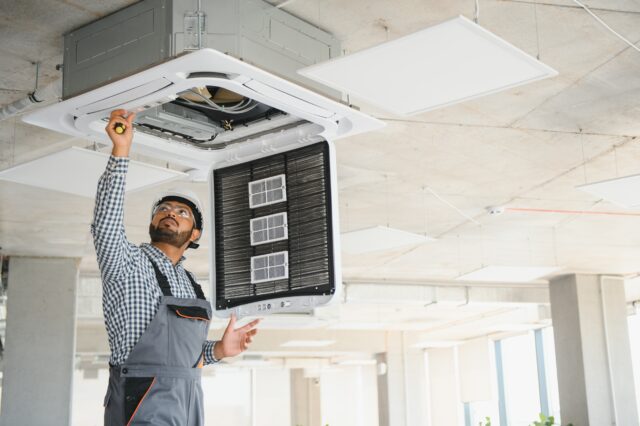In an era where health, sustainability, and operational resilience are top priorities, the role of Heating, Ventilation, and Air Conditioning (HVAC) systems has evolved far beyond basic temperature control. For facility managers, healthcare administrators, and building owners, modernizing HVAC systems is now a strategic imperative to ensure better indoor air quality (IAQ), improve energy efficiency, and create safer environments for occupants.
This article explores the critical need for HVAC upgrades, key modern technologies driving the change, and how facilities can position themselves for long-term success.
The New Role of HVAC: Health, Safety, and Efficiency
Historically, HVAC systems were designed to maintain comfort — heating buildings in the winter and cooling them in the summer.
Today, that’s no longer enough.
Post-pandemic realities and rising awareness of environmental concerns have transformed indoor air management into a cornerstone of operational excellence. Building stakeholders are now expected to provide:
- High-quality, pathogen-free air
- Smart energy use aligned with sustainability goals
- Flexible systems that adapt to occupancy patterns and environmental changes
Poor IAQ has been directly linked to higher rates of absenteeism, reduced cognitive function, and increased long-term health risks. In sensitive sectors like healthcare, where patients with compromised immune systems are involved, the consequences can be even more severe.
Why Facilities Must Prioritize HVAC Modernization
Several factors are converging to make HVAC upgrades an urgent priority:
1. Health and Safety Regulations
Governments and regulatory bodies are introducing stricter indoor air quality standards across many sectors, especially healthcare, education, and commercial real estate.
Failure to meet these standards can result in penalties, reduced occupancy certifications, or even lawsuits.
2. Energy Efficiency and Cost Savings
Old HVAC systems are often massive energy hogs, accounting for up to 40% of a facility’s total energy use.
Modern systems, on the other hand, are designed to:
- Optimize power usage
- Recover waste energy
- Operate precisely based on real-time occupancy and external conditions
This translates into dramatic utility savings and smaller carbon footprints — critical goals for ESG (Environmental, Social, and Governance) reporting.
3. Resilience and Business Continuity
During future crises — whether pandemics, climate-related events, or energy shortages — buildings equipped with modern HVAC systems will be better positioned to maintain operations safely.
Resilient facilities protect occupants, preserve reputation, and minimize financial losses.
Key Technologies Driving Modern HVAC Upgrades
Let’s break down the smart innovations reshaping the future of building ventilation and climate control:
High-Efficiency Filtration and Air Purification
- HEPA Filters and MERV-13+ Filters: Capture up to 99.97% of airborne particles, including bacteria and viruses.
- Bipolar Ionization and UV-C Systems: Actively neutralize pathogens in circulating air, offering an additional layer of protection in critical settings like hospitals and labs.
IoT-Enabled Smart Controls
- Occupancy Sensors: Adjust airflow and temperature dynamically based on the number of people in a room.
- Smart Thermostats: Learn usage patterns over time to optimize HVAC operations.
- Remote Monitoring: Facilities teams can receive real-time alerts and performance data, making remote troubleshooting and energy management possible.
Energy Recovery Ventilation (ERV) Systems
- Capture and reuse heat or coolness from exhausted air to pre-condition incoming fresh air.
- Significantly reduce the energy burden without sacrificing air quality.
Predictive Maintenance Technologies
- IoT sensors can track system performance metrics like vibration, pressure, and temperature.
- Predictive analytics detect issues early, reducing the risk of catastrophic failures and costly emergency repairs.
Flexible and Modular System Designs
- Systems are being designed to allow quick retrofitting, zoning, and scaling — critical for facilities that need to pivot during surges, such as hospitals handling a pandemic or manufacturing plants dealing with demand spikes.
Step-by-Step: How to Approach HVAC Modernization
A successful upgrade isn’t just about buying new equipment. It’s about strategic planning and holistic execution:
1. Conduct a Comprehensive IAQ Assessment
Start with a full audit of your facility’s current air quality, ventilation rates, and HVAC system efficiency.
2. Define Your Goals
Decide whether your priority is energy savings, infection control, occupant comfort, or regulatory compliance — or a combination.
3. Select the Right Technologies
Not all upgrades are “one-size-fits-all.” Choose smart upgrades that align with your building’s needs and operational budget.
4. Plan for Phased Implementation
Depending on the building size and usage, a phased approach might make more sense, minimizing disruptions to operations.
5. Train Your Facilities Team
New systems require new knowledge. Invest in staff training to maximize the benefits of smart HVAC systems.
Real-World Benefits: Why HVAC Modernization Pays Off
Upgrading your facility’s HVAC system brings tangible, measurable advantages:
| Benefit | Impact |
|---|---|
| Healthier Environments | Reduced sickness, absenteeism, and healthcare costs |
| Lower Energy Costs | Up to 30–50% energy savings annually |
| Enhanced Reputation | Attract tenants, patients, or customers seeking healthier, sustainable spaces |
| Future-Proofing | Meet or exceed evolving regulations and standards |
| Higher Building Value | Modern facilities command higher rents and sale prices |







